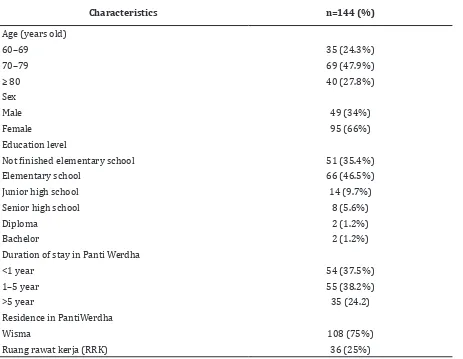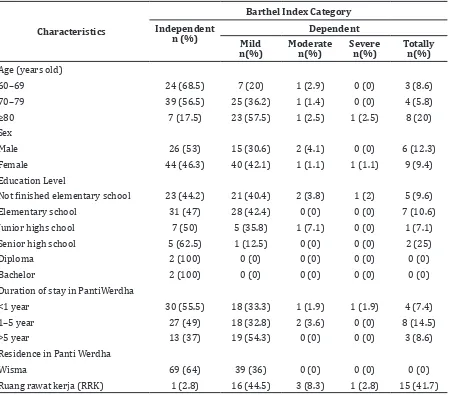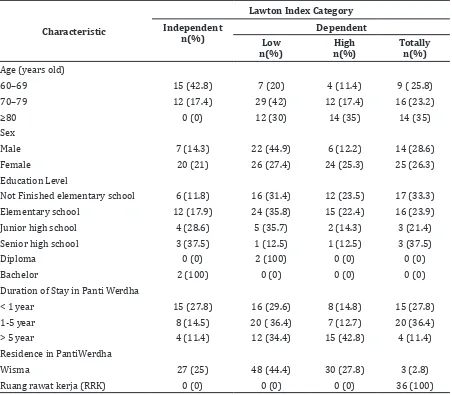Level of Dependency Based on Barthel and Lawton Score in Older
People Living in Panti Werdha, Ciparay
Rizky Nurwan Diyanto,1 Marina A. Moeliono,2 Lazuardhi Dwipa3
1Faculty of Medicine Universitas Padjadjaran, 2Department of Physical Medicine and Rehabilition Faculty of Medicine Universitas Padjadjaran/Dr. Hasan Sadikin General Hospital Bandung, 3Department of Internal Medicine Faculty of Medicine Universitas Padjadjaran/Dr. Hasan Sadikin
General Hospital Bandung
Abstract
Background:The population of older people continues to increase. Thus, many kinds of health-related
problems can occur, such as a decrease independence level in performing activities of daily living (ADL) which can be assessed by using Barthel and Lawton index. Barthel index assesses basic ADL such as mobility function, continence, and self-care. Lawton index assesses instumental ADL that are a person’s ability to
use tools and face other people. There are no data available reflecting the dependency of the older people
at Panti Werdha, Ciparay . This study aimed to observe the level of dependence of the older people in Panti Werdha using Barthel and Lawton index.
Methods: This study was a descriptive study and was conducted at Panti Werdha, Ciparay from September
to November 2015 using the total population. The level of dependence in the older people was assessed by Barthel and Lawton index. Barthel index was divided into independent, mild dependent, moderate dependent, severe dependent, and totally dependent. Lawton index was divided into independent, low dependent, high dependent, and totally dependent.
Results: A total of 144 older people participated as respondents in this study. Based on the Barthel index score, it showed that 51.4% of the subjects were dependent. As for the Lawton index scor¬¬e, it showed that 81.2% of the subjects were dependent.
Conclusions: Most of the older people in Panti Werdha, Ciparay are categorized as dependent, where they will need help in performing basic and instrumental ADL. [AMJ.2016;3(4):493–8]
Keywords: Activities of daily living, older people, panti werdha
Correspondence: Rizky Nurwan Diyanto, Faculty of Medicine, Universitas Padjadjaran, Jalan Raya Bandung-Sumedang Km.21, Jatinangor, Sumedang, Indonesia, Phone: +6285315265858 Email: rizky.x5@gmail.comoo.co.id
Introduction
Older people are those who are aged 60 years and older. The population of older people continues to increase every year worldwide. The number of older people in Indonesia in 2013 reached 20.04 million people, or approximately 8.05% of the population. It is estimated that by 2020, the population of older people would reach 11.34% of the entire population in Indonesia.1 It may lead to many problems that commonly arise in older people. One of which is a decrease in functional status.2
Furthermore, the functional status can be described as a person’s level of independence in performing activities of daily living (ADL).
The functional status of a person can be assessed by using ADL score.2,3 ADL are divided into basic ADL and instrumental ADL.4–7 Basic ADL is associated with a person’s ability to meet the needs of self-care (eating, bathing, toileting, dressing, etc.), continence, and mobility (walking).4,8,9 While Instrumental ADL is more complex than Basic ADL. Instrumental ADL relates to a person’s ability to perform task and use of tools such as using a telephone, shopping, preparing meals, housekeeping, washing, transportation
use, drug use, and managing finances.6,7 Basic ADL can be assessed using the Barthel index, whereas instrumental ADL can be assessed using the Lawton index.5,6
need for older people.10Panti Werdha is a residence for older people.11 They will accept those who are physically independent. During their stay, those older people can become dependent. Besides Panti Werdha, Ciparay has a special room (ruang rawat kerja, RRK) for older people who are considered unable to perform ADL independently. Additionally,
the data profile reflecting the independence
or dependence of the older people in Panti
Werdha, Ciparay is unavailable. This profile is
needed to plan programs conducted in the Panti Werdha and for reporting to the government on the functional status of the older people in Panti Werdha. The implementation of the Panti Werdha’s program for the older people’s activities is one of the strategy to increase or maintain the level of independence of older people in performing daily activities.2 This study aimed to observe the level of dependence of the older people using the Barthel and Lawton index at Panti Werdha,
Ciparay, Bandung district.
Methods
This study was a descriptive study, where the subjects were older people who were enrolled in the Panti Werdha, Ciparay, Bandung District. This study was approved by the Health Research Ethics Committee, Faculty of Medicine, Universitas Padjadjaran. The older people were selected as subjects in this study by using the total population. Data were collected during the period of September to November 2015. The total number of respondents was 144 older people who signed the informed consent form. The inclusion criterion for this study was older people residents. The exclusion criterion for this study was older people who refused to participate in the study.
This study used the Barthel index to assess basic ADL and Lawton index to assess instrumental ADL by interviewing the
Table 1 Respondent Characteristics
Characteristics n=144 (%)
Age (years old)
60–69 35 (24.3%)
70–79 69 (47.9%)
≥ 80 40 (27.8%)
Sex
Male 49 (34%)
Female 95 (66%)
Education level
Not finished elementary school 51 (35.4%)
Elementary school 66 (46.5%)
Junior high school 14 (9.7%)
Senior high school 8 (5.6%)
Diploma 2 (1.2%)
Bachelor 2 (1.2%)
Duration of stay in Panti Werdha
<1 year 54 (37.5%)
1–5 year 55 (38.2%)
>5 year 35 (24.2)
Residence in PantiWerdha
Wisma 108 (75%)
respondents directly. When the respondents
had difficulty answering the question, they
would be aided by a nurse of Panti Werdha. The Barthel index is one of the tools to assess the mobility function, continence and self-care such as eating, bathing, and dressing. The Lawton index assesses a person’s ability to use tools or face other people or the environment, such as preparing meals, using the telephone, writing, typing, shopping and housekeeping.12 The minimum score of Barthel index is 0 and the maximum is 20. The minimum score of Lawton index is 0 and the maximum is 8. The Interpretation of Barthel index scores are as follows, independent (20) and dependent (0–19). The level of dependency in the Barthel index were divided into categories: mild dependent (12–19), moderate dependent (9–11), severe dependent (5–8), and totally dependent (0–4). The Lawton index scores were divided into independent (8) and dependent (0–7). The level of dependency in the Lawton Index were divided into three categories, low dependent, high dependent, and totally dependent.13
Results
A total of 144 older people participated as respondents in this study. The characteristics of the older people at Panti Werdha, Ciparay
showed that nearly half of the older people were aged 70–79 years (47.9%). The number of female respondents was higher than male respondents. The majority of the respondents were elementary school graduates (45.8%). The number of respondents who have lived in the Panti Werdha for 1–5 years were 55 (38.2%).While the majority of the residents lived in Wisma (80%) (Table 1).
Furthermore, the majority the older people were categorized as dependent based on the Barthel index. The older people categorized as dependent are further divided into sub categories: mild dependent, moderate dependent, severe dependent, and totally dependent. The majority of the older people were categorized as mild dependent and totally dependent (Table 2).
According to the Lawton index, the majority of the older people were categorized as dependent in performing instrumental ADL (81.2%). Based on this results, most of the older people need help in performing instrumental ADL (Table 3).
The majority of the independent older people were in the age groups of 60–69 years and 70–79 years, whereas the majority of the dependent older people were in the age
category of ≥80 years. The percentage of
independent male (53%) was higher than female (46.3%). The majority of the older Table 2 Frequency Level of Dependency of Older People Based on Barthel Index Score in
Performing Basic ADL
Independence Level Score Category Frequency Percentage (%)
Independent 20 70 48.6
Dependent 0–19 74 51.4
Mild dependent 12–19 55 74.32
Moderate dependent 9–11 3 4.05
Severe dependent 5–8 1 1.35
Totally dependent 0–4 15 20.28
Table 3 Frequency Level of Dependency of Older People Based on Lawton Index score in Performing Instrumental ADL
Independence Level Score Category Frequency Percentage
Independent 8 27 18.8%
Dependent 0–7 117 81.2%
Low dependent 5–7 48 33.3%
High dependent 2–4 30 20.8%
people who did not graduate and graduated from elementary schools were dependent. There was a decrease in the independence level of those who have lived at Panti Werdha
for more than 5 years. There was a significant
difference in dependency levels when comparing older people living in Wisma to those living in Ruang rawat kerja (RRK). The majority of the people living in Wisma were independent while the others living in RRK were dependent (Table 4).
Additionally, the level of independence of the older people based on the Lawton index showed that the majority of them were dependent, with no independent older people
in the age group of ≥80 years . The percentage
of independence level in female (21%) was higher than those in male (14.3%). Older
people who did not complete elementary school had a lower percentage of independence level. The older people who had lived at the Panti Werdha for more than 5 years had the lowest percentage of independence level. Everyone living in RRK was categorized as totally dependent based on the Lawton index (Table 5).
Discussion
The majority of the older people were in the age category of 71–79 years (47.9%). The majority of the dependent older people were in the age
category of ≥80 years. It can be concluded
that older residents of the Panti Werdha have lower level of independence. This is consistent
Table 4 Profile Level of Dependency of Older People Based on Their Characteristics and
Barthel Index Category
Characteristics
Barthel Index Category
Independent n (%)
Dependent
Mild n(%)
Moderate n(%)
Severe n(%)
Totally n(%)
Age (years old)
60–69 24 (68.5) 7 (20) 1 (2.9) 0 (0) 3 (8.6) 70–79 39 (56.5) 25 (36.2) 1 (1.4) 0 (0) 4 (5.8)
≥80 7 (17.5) 23 (57.5) 1 (2.5) 1 (2.5) 8 (20) Sex
Male 26 (53) 15 (30.6) 2 (4.1) 0 (0) 6 (12.3) Female 44 (46.3) 40 (42.1) 1 (1.1) 1 (1.1) 9 (9.4) Education Level
Not finished elementary school 23 (44.2) 21 (40.4) 2 (3.8) 1 (2) 5 (9.6)
Elementary school 31 (47) 28 (42.4) 0 (0) 0 (0) 7 (10.6) Junior highs chool 7 (50) 5 (35.8) 1 (7.1) 0 (0) 1 (7.1) Senior high school 5 (62.5) 1 (12.5) 0 (0) 0 (0) 2 (25)
Diploma 2 (100) 0 (0) 0 (0) 0 (0) 0 (0)
Bachelor 2 (100) 0 (0) 0 (0) 0 (0) 0 (0)
Duration of stay in PantiWerdha
<1 year 30 (55.5) 18 (33.3) 1 (1.9) 1 (1.9) 4 (7.4) 1–5 year 27 (49) 18 (32.8) 2 (3.6) 0 (0) 8 (14.5) >5 year 13 (37) 19 (54.3) 0 (0) 0 (0) 3 (8.6) Residence in Panti Werdha
Wisma 69 (64) 39 (36) 0 (0) 0 (0) 0 (0)
with a theory which states that age is the most affecting factor in independence.2,12,13
Furthermore, the number of female was higher than male residents. This was due to the population of older women was higher than older men which is consistent with the epidemiology of older people population.The population of older women reaches 10.67 million people (53.2%) and older men reaches 9.37 million (46.7%) due to the fact that the life expectancy of women is higher than men, based on three key factors: genetic, hormonal, and heart disease risk.1,14 Based on the Barthel index, the percentage of independent male (53%) was higher than female (46.3%). While based on the Lawton index the percentage of independent female (21%) was higher than that of male (14.3%).
The majority of the older people who had low education level were dependent based on the Barthel and Lawton index. This result was similar with a previous study by Punet et al.15 in India.This study stated that education level have a positive impact on dependency status.15
A total of 108 older people were living in Wisma, while 36 others were living in RRK. The Wisma at Panti Werdha, Ciparay was occupied by older people who were able to perform ADL independently and were able to join in several activities held by the Panti Werdha, while RRK was occupied by older people who were considered unable to perform ADL independently or in need of special monitoring. Panti Werdha does not have the instruments which the older people should be nursed in RRK. This was consistent with the study result
Table 5 Profile Level of Dependency of OlderPeople Based on Their Characteristics and
Lawton Index Category
Characteristic
Lawton Index Category
Independent n(%)
Dependent
Low n(%)
High n(%)
Totally n(%)
Age (years old)
60–69 15 (42.8) 7 (20) 4 (11.4) 9 ( 25.8)
70–79 12 (17.4) 29 (42) 12 (17.4) 16 (23.2)
≥80 0 (0) 12 (30) 14 (35) 14 (35)
Sex
Male 7 (14.3) 22 (44.9) 6 (12.2) 14 (28.6)
Female 20 (21) 26 (27.4) 24 (25.3) 25 (26.3) Education Level
Not Finished elementary school 6 (11.8) 16 (31.4) 12 (23.5) 17 (33.3) Elementary school 12 (17.9) 24 (35.8) 15 (22.4) 16 (23.9) Junior high school 4 (28.6) 5 (35.7) 2 (14.3) 3 (21.4) Senior high school 3 (37.5) 1 (12.5) 1 (12.5) 3 (37.5)
Diploma 0 (0) 2 (100) 0 (0) 0 (0)
Bachelor 2 (100) 0 (0) 0 (0) 0 (0)
Duration of Stay in Panti Werdha
< 1 year 15 (27.8) 16 (29.6) 8 (14.8) 15 (27.8) 1-5 year 8 (14.5) 20 ( 36.4) 7 (12.7) 20 (36.4) > 5 year 4 (11.4) 12 (34.4) 15 (42.8) 4 (11.4) Residence in PantiWerdha
Wisma 27 (25) 48 (44.4) 30 (27.8) 3 (2.8)
indicating that the older people living in RRK had lower level of independence compared to those living in Wisma. The percentage of independent older people in Wisma was 63.89% in accordance with Barthel index and 25% using Lawton index. As for those living in RRK, it was 2.8% based on Barthel index and 0% using Lawton index.
Based on the study result, a conclusion can be made that 51.4% of older people are categorized as dependent in performing basic ADL and the majority of the older people in Panti Werdha, Ciparay (81.2%) are categorized as dependent in performing instrumental ADL. This shows that most of the older people in Panti Werdha,Ciparay need help to perform their basic and instrumental ADL. Panti werdha has a big burden for caring dependent older people. This is interesting for conducting a further study about intervention that can increase the level of independence of older people. The limitation of this study was that it was only conducted in one Panti Werdha. It can be suggested for a further study to observe the level of dependency of the older people in more than one Panti Werdha. Moreover, it can be suggested to the Panti Werdha to conduct programs that would improve, maintain, and monitor the level of independence of the older people in performing daily activities in the Panti Werdha. Besides, Panti Werdha needs instruments to determine older people who should live in RRK. These study results can be reported to the government to show the
profile level of independence residents in
Panti Werdha, Ciparay.
References
1. Badan Pusat Statistik. Statistik Penduduk Lanjut Usia. Jakarta: Badan Pusat Statistik Indonesia; 2013.
2. Setiati S. Geriatri dan gerontologi. In: Siti Setiati, Idrus Alwi, Aru W. Sudoyono, Marcellus Simadibrata, Bambang Setiyohadi AFS, editors. Buku ajar ilmu penyakit dalam. 6th ed. Jakarta: Interna Publishing; 2014. p. 3669–893.
3. Millán-Calenti JC, Tubío J, Pita-Fernández S, González-Abraldes I, Lorenzo T, Fernández-Arruty T, et al. Prevalence of functional disability in activities of daily living (ADL), instrumental activities of daily living (IADL) and associated factors, as predictors of morbidity and mortality. Arch Gerontol Geriatr. 2010;50(3):306–10. 4. De Paula JJ, Bertola L, De Ávila RT, Assis
LDO, Albuquerque M, Bicalho M, et al.
Development, validity, and reliability of the general activities of daily living scale: a multidimensional measure of activities of daily living for older people. Rev Bras
Psiquiatr. 2014;36(2):143–52.
5. Lee Y-C, Chen S-S, Koh C-L,Hsueh I-P, Yao K-P, Hsieh C-L. Development of two barthel index-based supplementary scales for patients with stroke. PLoS One. 2014;9(10):1–8.
6. Graf C. The Lawton instrumental activities of daily living scale. Am J Nurs. 2008;108(4):53–62.
7. Park B, Jun JK, Park J. Cognitive impairment and depression in the early 60s: which is more problematic in terms of instrumental activities of daily living? Geriatr Gerontol Int. 2014;14(1):62–70.
8. Weening E. Frail institutionalized older
persons : a comprehensive review on
physical exercise. Am J Phys Med Rehabil. 2015;90(1):156–68.
9. Kruse RL, Petroski GF, Mehr DR, Banaszak-Holl J, Intrator O. Activity of daily living trajectories surrounding acute hospitalization of long-stay nursing home residents. J Am Geriatr Soc. 2013;61(11):1909–18.
10. Matsui Y, Fujita R, Harada A, Sakurai T, Nemoto T, Noda N, et al. Association of grip strength and related indices with independence of activities of daily living in older adults, investigated by a newly-developed grip strength measuring device. Geriatr Gerontol Int. 2014;14(2):77–86. 11. Darmojo B. Berbagai pelayanan pada usia
lanjut. In: Hadi Martono KP, editor. Buku ajar geriatri (ilmu kesehatan usia lanjut). 4th ed. Jakarta: Balai Penerbit FKUI; 2009. p. 717–800.
12. Mohanty S, Gangil OP, Kumar S. Instrumental activities of daily living and subjective wellbeing in elderly persons living in community. Indian J Gerontol. 2012;26(2):193–206.
13. Dolai MC, Chakrabarty F, Emmanuel D, Bordoloi H, Butt TI, Awoyemi-Arayela T, et al. Functional status of the elderly santal people. Indian J Gerontol. 2013;27(4):610– 20.
14. Eskes T, Haanen C. Review: why do women live longer than men? Eur J Obstet Gynecol. 2007;133(2):126–33.



